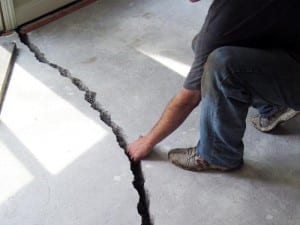The foundations of a building or support structure, whether in a residential or commercial location, are paramount to the integrity of the building.
Let’s start off by saying that cracking in your concrete slab or floor cannot be totally prevented. Fortunately by paying attention to the causes and taking preventative steps, cracking can be significantly reduced or controlled.
Why are foundations so important
The purpose of a foundation is not only to anchor the structure to the earth, it also contributes to the structures’ integrity.From a structural point of view these requirements are obvious, but the substructure also has the responsibility of resisting water, ice, fungus, insects, soil gases and soil pressures.

Large crack in a concrete slab
Why foundations crack should never be ignored
Cracks in concrete slabs can range from relatively minor to major concerns.
Hence, correct analysis of any cracking is required to allow for appropriate measures to be taken.
At a minimum, cracks can be a source of water entry, form tripping hazards and simply be unsightly. At its worst, structural integrity can be compromised.
For example, in the case of a wall, when a crack is not too wide, not located in a structural position or leaking water it is generally seen to be acceptable.
To reduce and control cracking while also appropriately advising on the nature of any cracks which do form, it takes knowledge and experience during the design / construction phase and beyond.
Now let’s take a look at some of the causes and features of concrete cracking.
Causes and types of foundation cracking
Typically cracking is grouped into two broad categories:
1. Cracks occurring before and during hardening
2. Cracks occurring after hardening of concrete
Within these categories crack formation was approximately attributed to the following (Holcim, 2016):
• Construction and supervision problems – 36%
• Design Defects – 27%
• Ambient conditions – 21%
• Quality of materials – 17%
When a crack occurs before and during hardening this is usually a result of settlement or surface shrinkage.
Foundation settlement
Foundation settlement can occur from several factors, some more manageable than others, there include:
1. Drying and shrinking soil: Environmental factors such as droughts and large trees can cause soil to lose much of its moisture, causing it to shrink. This causes the foundations to settle as well.
2. Wetting, softening soil: Adversely, when the soil beneath a foundation becomes wet and soft, a similar downward movement may occur. This issue can be combated using proper drainage management during the design of the foundations.
3. Poorly compacted fill soils: When a new concrete slab is required the existing foundations are often uneven, hence requiring fill soils to correct for any uneven ground. Since the existing soil is hard packed, if the loose fill soil is not properly compacted the eventual weight of the structure above will do so, potentially causing uneven settling and damage.
How can these issues be avoided?
Given that approximately 63% of foundation cracking (Holcim, 2016) results from errors during both the design and construction phases, it is imperative to ensure these stages are diligently handled to avoid future issues.
Rapallo’s Civil Engineers not only have the capability to complete inspections of concrete slabs, but also formulate and execute options for repair.
These capabilities extend from commercial projects to residential homes. If you require assistance in building a retaining wall, a slab, shed foundations or even obtaining council approval, Rapallo has you covered.
Anyone can knock up form work and pour concrete mixed in a wheel barrow, but you risk major structural issues down the line. Rapallo can design, draft and certify residential constructions for council approvals.
